Managements of a multiplying number of cool alternative schools take a broader view of education than mere academic excellence and are providing a varied mix of experiential and life skills learning, cognitive development, environment awareness and co-curricular and sports education - Summiya Yasmeen

Within India’s 60 million upwardly mobile middle class households which have some idea of the giant leaps in digital technologies, artificial intelligence and robotics as also of the high incidence of substance use, violent crimes and breakdown of family values in developed Western democracies, there’s growing disquiet about the contemporaneity, quality and direction of K-12 education being dispensed in the country’s schools. While the great majority of parents passively accept the archaic pedagogies, syllabuses and curriculums of the country’s 34 examination boards prescribed to 1.20 million government and 320,000 private schools, a small but discerning minority within the middle class is becoming aware that hapless and vulnerable children even in top-ranked schools are trapped in a high-stress daily round of mugging texts, top-up tutorials and perpetual fear of achieving the high admission cut-offs routinely demanded by the nation’s too-few top-ranked undergraduate colleges and u niversities. Within 21st century India’s pressure-cooker education system, a school/college student commits suicide every hour, according to latest National Crime Records Bureau data.
Fortunately, for the growing minority of parents dissatisfied with drill-and-skill schooling, child-sensitive new-age schools are springing up across the country offering alternatives to oppressive mainstream education. The managements of a rising number of cool alternative schools take a broader view of education than mere academic excellence which translates into subjects-centred accumulation of facts and information, and continuous testing, and are providing a varied mix of experiential and life skills learning, cognitive development, environment awareness and co-curricular and sports education.
“Alternative education is an organic and constantly evolving approach to learning. It makes the child the centre and focus of learning, using a variety of methods and strategies. It is not rote learning and it does not treat children as empty vessels to be filled with knowledge. It is an alternative to priority given solely and exclusively to passing examinations, to achieving results and ranking, to preparing children to ‘make it’ in today’s world using conventional yardsticks of success... In summary, alternative education philosophy endeavours to fit the process of learning to the child’s inclinations, interests and abilities,” writes Sarojini Vittachi, an alum of the London School of Economics, former Unicef executive and author of Alternative Schooling in India (Sage Publications, 2007).
Unsurprisingly over the past decade since the book was published, the number of alternative schools has multiplied with several educationists and edupreneurs with reformist ideas stepping forward to provide over-stressed children alternatives to the one-size-fits-all education system. “The alternative education space has become more diversified, more available and popular with parents. This is because of the growing disillusionment with mainstream schools which are doing too little to break away from rote learning, competition and exams testing. As we move towards an uncertain future, parents are realising that life skills will be the game-changers of the 21st century. Also the success of pioneer alternative schools such as Rishi Valley and their alumni has emboldened parents to experiment with their children’s education. They are beginning to see great value in alternative schools which are equipping children for success in life, not merely careers,” says Indira Vijaysimha, an alumna of the National Institute of Advanced Studies (NIAS), Bangalore and professor of education at Azim Premji University, and also the founder-trustee of Poorna Learning Centre, Bangalore, an alternative school promoted by her in 1993, which currently has an enrolment of 150 students.
Certainly some of the country’s pioneer alternative schools such as the Rishi Valley School, Chittoor (RVS, estb. 1926) and The Valley School, Bangalore (1978) — promoted to teach according to the precepts and practices of education visionary Jiddu Krishnamurti (1895-1986) — have captured the imagination of the influential upper middle class. In the pioneer EducationWorld India School Rankings league tables which annually rate and rank the nation’s Top 1,000 schools in three major (day, boarding and international) and 14 sub-categories (co-ed, all-boys, girls, day-cum-boarding etc), SEC (socio-economic category) ‘A’ sample respondents (parents, teachers, senior students) routinely vote RVS — established by Krishnamurti almost a century ago — as #1 in the category of co-ed boarding schools. Likewise, the Bangalore-based Valley School promoted by the Krishnamurti Foundation of India, is continuously voted among the country’s top 5 co-ed day schools (see EW September 2017 in www.educationworld.in archives).
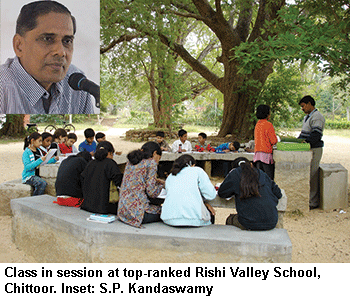 If we focus very much on examinations, on making the child clever, proficient in acquiring knowledge, then the child will grow into a one-sided human being… To make a child a worthwhile human being, schools should focus on developing in a child the right feeling for beauty, a response to nature, to music and art, a highly developed aesthetic sense,” said Krishnamurti in one of his public discourses on the purpose of education.
If we focus very much on examinations, on making the child clever, proficient in acquiring knowledge, then the child will grow into a one-sided human being… To make a child a worthwhile human being, schools should focus on developing in a child the right feeling for beauty, a response to nature, to music and art, a highly developed aesthetic sense,” said Krishnamurti in one of his public discourses on the purpose of education.
Although in the early decades after independence, the country’s legacy boarding schools such as Doon, Bishop Cotton (Shimla and Bangalore), St. Paul’s and St. Joseph’s, Darjeeling, Sherwood, Nainital, Woodstock, Mussoorie and Kodaikanal International remained the preferred choice of SEC ‘A’ households, Krishnamurti’s ideas on alternative education struck a chord within some educationists and teachers who constituted the Rishi Valley Trust in 1928 (re-christened the Krishnamurti Foundation India in 1970) with a mandate to promote alternative schools on the RVS model in different parts of the country. Today, KFI supervises six schools countrywide with a modest aggregate enrollment of 1,500 students mentored by 300 teachers.
Affiliated with the Delhi-based Council of the Indian School Certificate Examinations (CISCE) and Central Board of Secondary Education (CBSE), they are all highly ranked in the annual EducationWorld India School Rankings with RVS consistently ranked India’s #1 co-ed boarding school for a record six years (2011-2017) with the exception of 2014 when it was ranked #2. Contradicting the popular belief that liberal education results in low board exam scores, RVS is regularly numbered among the Top 10 CISCE-affiliated schools in class X and XII exam average scores.
Set in nature-friendly campuses, KFI schools lack the shiny trappings of upscale boarding and international schools — excellent architecture, manicured lawns and gardens, snappy uniforms, drills, brass bands etc — and are committed to vegetarianism. Dormitories are spartan, but KFI schools are big on co-curricular education — dance, music, fine arts, theatre, and particularly ecology and environment education.
“Guided by the teachings of J. Krishnamurti, KFI schools provide environments in which children can realise their full potential, develop a global outlook, love of nature and learn without the pressure of crude competition. All our six KFI schools have excellent national reputations with a very high ratio of applications to annual intake. Our alumni are doing exceedingly well in their chosen professions around the world. This education philosophy which focuses on children’s wholesome development on nature-friendly campuses without diluting academic standards, should be mainstreamed so every child can realise her true potential,” says S.P. Kandaswamy, the Chennai-based secretary of the Krishnamurti Foundation India, who adds that the Brockwood Park School, UK, run by the Krishnamurti Foundation Trust, England and Oak Grove School, USA of the Krishnamurti Foundation of America are also “doing very well”.
Krishnamurti’s liberal holistic education philosophy has inspired the promotion of several alternative schools including the Centre for Learning, Bangalore (estb. 1990), Walden’s Path School, Hyderabad (2014), and Shibumi School, Bangalore (2008) among others (see box p.47). Moreover, during the past two decades as a response to market demand, several schools inspired by other alternative education philosophers have struck root in India. The most popular of the foreign gurus is Austrian philosopher and social reformer Rudolph Steiner (1862-1925).
Before Krishnamurti, Steiner stressed the importance of providing children intellectual, practical and artistic education in non-stressful environments. Popularly known as Waldorf education (the first school based upon Steiner’s ideas was promoted in 1919 by Emil Molt, the owner of the Waldorf-Astoria Cigarette Company in Stuttgart, Germany, hence the name Waldorf). Steiner’s theory of child development divides childhood into three developmental stages and prescribes child-friendly curriculums for each stage. For instance in Waldorf schools, early childhood curriculums focus on hands-on activities and creative play; elementary curriculums develop artistic expression and socialisation life skills and in secondary education, the emphasis is on developing students’ critical thinking, reasoning and empathy skills. Currently, there are over 1,000 Waldorf schools worldwide.
|
The Summerhill experiment
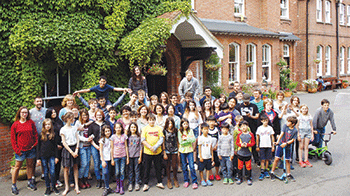 Every alternative or new age education institution worldwide has to a greater or less degree been inspired or influenced by the Summerhill School founded by educationist A.S. Neill in Suffolk (UK), in 1921. Promoted as a unique, progressive, co-education residential school, the prime objective of Summerhill was — and continues to be — “free from fear” schooling. Today, Summerhill which has a modest enrolment of 75 students, is managed by Neill’s daughter Zoe Readhead. Every alternative or new age education institution worldwide has to a greater or less degree been inspired or influenced by the Summerhill School founded by educationist A.S. Neill in Suffolk (UK), in 1921. Promoted as a unique, progressive, co-education residential school, the prime objective of Summerhill was — and continues to be — “free from fear” schooling. Today, Summerhill which has a modest enrolment of 75 students, is managed by Neill’s daughter Zoe Readhead.
The two distinctive features of the K-12 Summerhill, which were considered utopianly radical, were that classes would be optional, and its weekly meeting in which the school’s administrative rules and regulations were made and amended by a democratic assembly of faculty and students. Even to this day, these two foundational principles of Summerhill School haven’t been accepted by educationists anywhere in the world.
However since it was founded in 1921, the school has had a chequered history. Promoted at a time when British-style public school education was widely respected around the world, Summerhill created a storm of controversy and widespread apprehension that it would encourage anarchy in education. The consensus among educationists was that given the option, few children would voluntarily attend classes.
Consequently, Summerhill never captured the popular imagination and was dismissed as a parking lot for the children of aristocratic left-wing intellectuals and social rebels. Neill continued to run the school which attracted a large number of children of the rich and famous from overseas (particularly Japan), until his death in 1973. Subsequently, his wife Ena took charge until her retirement in 1985 when their daughter Zoe, the current headteacher, took over.
In 2000, the British government’s department of education and employment issued a closure order against Summerhill following inspectors’ reports of inadequate tuition and assessment. However, the school won an appeal against the closure order before the Independent Schools Tribunal forcing then education secretary David Blunkett to formally accept the right of children to skip classes.
Under a new agreement with Britain’s Office for Standards in Education, education inspectors continue to monitor Summerhill to ensure that agreed terms and conditions are implemented. According to Readhead, Summerhill is now the most legally protected school in the country, with a unique inspection process which respects children’s opinions.
|
The first Waldorf school in India — Sloka — The Hyderabad Waldorf School — was promoted in 1997 by Nirmala 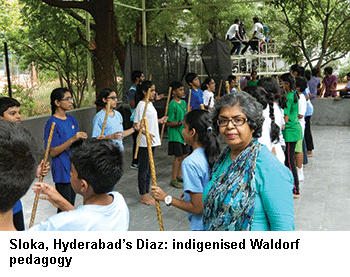 Diaz, a parent frustrated with the “limitations of conventional schooling”. Currently, this K-10 CBSE-affiliated school has 625 students mentored by 60 teachers on its muster rolls.
Diaz, a parent frustrated with the “limitations of conventional schooling”. Currently, this K-10 CBSE-affiliated school has 625 students mentored by 60 teachers on its muster rolls.
“Steiner/Waldorf education, which celebrates its centenary next year, is one of the world’s fastest growing education philosophies. We deliver child-centric, age-appropriate experiential learning with the objective of nurturing children’s self-esteem and confidence. In Sloka, there are no textbooks for classes I-VIII with children learning freely and joyously in class. Rhythm, repetition and recall are the 3 Rs of Waldorf learning with academic instruction delivered through storytelling, visual arts, drama, movement, vocal and instrumental music, and crafts. Handwork skills such as sewing and knitting, woodwork, music and dance, games and gymnastics are also integral to the curriculum. Moreover, in Sloka we have indigenised the curriculum, but we regularly host Waldorf master trainers from Switzerland, Germany, USA and Norway to train our teachers. The liberal, child-friendly Waldorf pedagogy we have adopted has improved learning outcomes. Children score well above average in the class X CBSE board exams and are admitted into the best universities in India and abroad,” says Diaz, an alumna of the Stella Maris College, Chennai, former advertising professional and founder-trustee of Sloka.
Over the past two d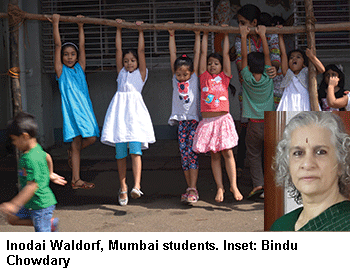 ecades, 29 Waldorf schools have been established in India. Among them is the Inodai Waldorf School, Mumbai, established in 2011 by the Education for Emancipation Trust. According to Bindu Chowdary, founder-trustee of this K-VII school which has 270 students and 32 teachers on its muster rolls, the prime motivation for starting the school was “deep dissatisfaction with an outdated system of education suited for creating clerks”.
ecades, 29 Waldorf schools have been established in India. Among them is the Inodai Waldorf School, Mumbai, established in 2011 by the Education for Emancipation Trust. According to Bindu Chowdary, founder-trustee of this K-VII school which has 270 students and 32 teachers on its muster rolls, the prime motivation for starting the school was “deep dissatisfaction with an outdated system of education suited for creating clerks”.
“In my opinion, the purpose of education is not merely to prepare children for employment, but to create love for lifelong learning in them, enabling them to live meaningful lives. In the Waldorf school system, head, heart and hands are nourished at appropriate ages in non-stressful learning environments. The unique feature of our schools is that teachers who begin teaching in class I continue to nurture and mentor their pupils’ intellectual and spiritual growth until they complete primary education, i.e, until class VIII. In secondary school, each class has a guardian teacher with experts brought in to teach specialised subjects such as nature studies, music, hand, clay and wood work, sewing, metal and stonework. In the process of learning this combination of subjects, children develop social and cultural life skills and other capabilities needed to live successful and happy lives. If we want to create a happy, healthy and humane society, schooling in India has to be lifted out of the rut of exams-focused education,” says Chowdary, an alumna of Mumbai University and former principal of MPSP Singh College, Mumbai and facilitator at the Centre for Steiner Education & Teacher Training, Mumbai.
Refreshingly, India’s latter-day deep-thinking educators tend to be innovators who study offshore education philosophies and pedagogies and not only adapt them to Indian conditions but improve upon them. A case in point is the husband-wife duo of Santhya Vikram and Vikram C. J. who promoted the Yellow Train School (YTS, estb.2008) down south on the periphery of the textile city of Coimbatore (pop. 1.6 million).
YTS is affiliated with Edexcel, Britain’s largest school examinations board, and offers a unique curriculum drawn from Waldorf and the education philosophies and practices of Rabindranath Tagore and Shri Aurobindo. Sited on a 33 acre organic farm, the school’s natural campus offers a rich learning environment distinguished by green fields, peacocks, cattle, sheep and other farm animals. The unique school building designed by Biome Environment Solutions, Bangalore, features spacious, natural light classrooms, slides running from the upper floor balconies to lower floors, ramps and tunnels and an amphitheatre. Arrangements to transform two Indian Railway carriages to house a library which will be open to residents of Coimbatore, are nearing completion.
“YTS is inspired by Totto-chan, the Little Girl at the Window, an autobiographical memoir of Japanese educationist Tetsuko Kuroyanagi, which recounts the transformative education he received in a school operating within several abandoned railway carriages during World War II. Throughout a 15-year career in industry, I sustained a dream of building a school where children could learn and grow without stressful competition and fear of failure. YTS is the realisation of that dream. Our children learn joyfully amid verdant fields, orchards and coconut groves, and learn to read and write through fairy tales. Math and science is learned by way of games and activities supervised by teachers intensively trained in Waldorf pedagogy. Though we don’t conduct formal exams until class V, learning outcomes are important. Senior school students follow the rigorous and well-designed syllabus of Edexcel setting their own learning attainment goals together with teachers to cover their portions. Moreover we are an inclusive school with 20 percent of our students comprising children with special needs,” says Santhya Vikram, an alumna of Bharathiar University and Xavier Institute of Management and Entrepreneurship, Bangalore, who co-promoted YTS in 2008 after a 15-year stint in the corporate world (ICICI Bank).
In this context, it is pertinent to note that a distinguishing characteristic of the country’s new-age alternative schools is that they aren’t enamoured with IT-enabled primary-secondary education and the Internet revolution. Although computers with multimedia-enabled gizmos are visible in classrooms, and excellent lectures and virtual classrooms are accessed through the Internet, the unique selling proposition of alternative schools is experiential learning in salubrious nature-friendly environments.
A few more adventurous and child-friendly educationists are venturing beyond the radicalism of KFI and Waldorf schools. They believe the managements of these schools aren’t fully independent as they are affiliated with Indian and foreign examination boards and as such, obliged to follow their prescribed syllabuses and to teach for board examinations, thereby preventing children to learn subjects of their choice and at their own pace. Therefore, they have ventured beyond the alternative system, consciously refraining from affiliating with any indigenous or offshore exam boards.
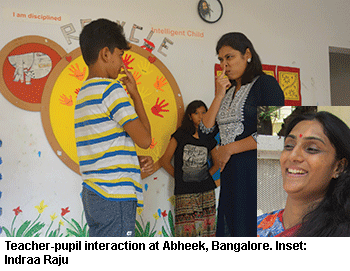 For instance, the class I-X Abheek Academy, Bangalore (estb.2014) is not affiliated with any examination board, Indian or foreign. “Mainstream school education is based on the factory model with students learning the same things collectively and following onerous syllabuses prescribed by government-inspired education bureaucrats. In Abheek, our prime objective is to provide experiential learning spaces and frameworks for children to realise their optimum potential in an atmosphere of freedom and responsibility. We give children a say in what and how they learn, with educators devising innovative games and mixed age group co-operative learning activities. The focus is on nurturing the individuality and socio-emotional development of children,” says M.S. Indraa Raju, founder of Abheek which currently has 25 students and eight parent educators/volunteers. “The learning centre will shortly be relocated in a 1.2-acre campus in Gottigere which can accommodate more children and adults, and provide space for playful learning-by-doing such as organic farming,” adds Raju.
For instance, the class I-X Abheek Academy, Bangalore (estb.2014) is not affiliated with any examination board, Indian or foreign. “Mainstream school education is based on the factory model with students learning the same things collectively and following onerous syllabuses prescribed by government-inspired education bureaucrats. In Abheek, our prime objective is to provide experiential learning spaces and frameworks for children to realise their optimum potential in an atmosphere of freedom and responsibility. We give children a say in what and how they learn, with educators devising innovative games and mixed age group co-operative learning activities. The focus is on nurturing the individuality and socio-emotional development of children,” says M.S. Indraa Raju, founder of Abheek which currently has 25 students and eight parent educators/volunteers. “The learning centre will shortly be relocated in a 1.2-acre campus in Gottigere which can accommodate more children and adults, and provide space for playful learning-by-doing such as organic farming,” adds Raju.
Likewise, the promoter-managers of BeMe School, Bangalore (estb. 2014) don’t want the school to be “tied to the apron strings” of any examination board and/or syllabus. Tucked away in a leafy bungalow in east Bangalore, the 6,000 sq.ft two-storied school building is shaded by a canopy of mango and banyan trees. Classrooms with benches and desks are conspicuously missing and children learn in activity centres, a well-equipped carpentry workshop, library with 800 books, computer centre that every student can access for two half-hour sessions per day, chemistry lab, sewing room, and sand pit. Nevertheless, the six students set to write the NIOS and IGCSE class X exam this year as private candidates are confident they will do well.
“We have learned at our own pace and have been tested at our own request. Therefore, it’s a joy to anticipate the challenge and write exams. We are pretty sure we will perform well,” says Astha Bhatt, a 15-year-old student of the school.
Prakash Gudnavar, co-fo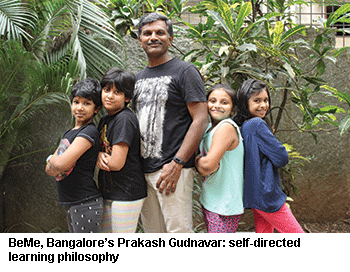 under of BeMe, says the school’s philosophy is to stimulate self-directed learning. “What, how, how much and with whom to learn, is left to students. Contrary to popular belief, children love to learn and acquire knowledge. Our role as teachers is to help them access learning resources, provide help and guidance if required. We regard our campus as an incubation space for independent learners who specialise voluntarily and naturally,” says Gudnavar, an alum of NIT, Suratkal who worked as a software engineer for 15 years with several multinational companies. Inspired by Aarohi Life Education, an alternative education centre in Hosur (Tamil Nadu) which his daughters attended, he promoted BeMe, which currently has 63 students aged 3-15 years facilitated by nine mentors on its muster rolls.
under of BeMe, says the school’s philosophy is to stimulate self-directed learning. “What, how, how much and with whom to learn, is left to students. Contrary to popular belief, children love to learn and acquire knowledge. Our role as teachers is to help them access learning resources, provide help and guidance if required. We regard our campus as an incubation space for independent learners who specialise voluntarily and naturally,” says Gudnavar, an alum of NIT, Suratkal who worked as a software engineer for 15 years with several multinational companies. Inspired by Aarohi Life Education, an alternative education centre in Hosur (Tamil Nadu) which his daughters attended, he promoted BeMe, which currently has 63 students aged 3-15 years facilitated by nine mentors on its muster rolls.
|
Some alternative schools in India
KARNATAKA
BeMe School, Bangalore. Estb. 2014. Open school, self-directed learning. School-leaving students write the National Institute of Open Schooling (NIOS) or the IGCSE (Edexcel, UK) exam as private candidates (www.beme.org.in).
Prakriya Green Wisdom School, Bangalore. Estb. 1999. Provides experiential, activity and enquiry-based learning. Affiliated with the Delhi-based Council for the Indian School Certificate Examinations (CISCE). (prakriyaschool.com)
Shibumi, Bangalore. Estb. 2009. Inspired by philosopher-seer J. Krishnamurti. School-leaving students write Cambridge Assessment International Education (CAIE), UK’s class X IGCSE and class XII A level exams as private candidates. (www.shibumi.org.in)
Poorna Learning Centre, Bangalore. Founded as a home-schooling centre in 1993. Follows mixed age group, inter-disciplinary pedagogies. Students write the NIOS/IGCSE exams. (www.poorna.in)
Abheek Academy, Bangalore. Estb. 2014. Allows children wide space for exploratory and experiential learning. School-leaving students write NIOS/IGCSE. (abheek.org)
The Valley School, Bangalore. Affiliated with CISCE. Promoted in 1978 by the Krishnamurti Foundation of India. (valleyschool.herokuapp.com)
Centre for Learning, Bangalore. Promoted in 1990 by former teachers of the Rishi Valley School, Chittoor. Class X students write the IGCSE exam. (cfl.in)
Andhra Pradesh
Rishi Valley School, Chittoor. Fully residential, co-ed, CISCE affiliation. Routinely ranked country’s #1 co-ed boarding school by EducationWorld. (www.rishivalley.org)
Tamil Nadu
Yellow Train School, Coimbatore. A Waldorf school affiliated with the Edexcel exams board, UK. (yellowtrainschool.com)
The School Krishnamurti Foundation India, Chennai. Estb. 1973. Affiliated with CISCE. (www.theschoolkfi.org)
Madhya Pradesh
Anand Niketan Democratic School, Bhopal. Children learn outside traditional classrooms, without a prescribed syllabus. Estb. 2012. (anbhopal.weebly.com)
Delhi
Mirambika — Free Progress School. Inspired by Sri Aurobindo (1872-1950). Mixed-age classes. Students write NIOS. (www.mirambika.org)
Ukti — The Delhi Waldorf School. Waldorf early childhood and primary school education. Estb. 2013. (www.uktiwaldorf.org)
Maharashtra
Camphill Nature School, Pune. Waldorf school. Estb. 2000. (www.camphillnatureschool.com)
Sahyadri School, Pune. A Krishnamurti Foundation school (estb. 1995). CISCE-affiliated. (www.sahyadrischool.org)
Tridha, Mumbai. Waldorf curriculum. Students write CAIE’s IGCSE exam. (www.tridha.com)
Kalpavruksha, Mumbai. Waldorf curriculum blended with nature-based education. Students write CAIE’s class X IGCSE exam. (kalpavruksha.weebly.com)
Telangana
Sloka — The Hyderabad Waldorf School. Estb. 1997. Affiliated with CBSE. (www.slokawaldorf.org)
Walden’s Path School, Hyderabad. K-12 school inspired by J. Krishnamurti. Students write CAIE’s IGCSE and A level exams. (waldenspath.com)
Uttar Pradesh
Rajghat Besant School, Varanasi. KFI-promoted residential class IV-XII school. Affiliated with CBSE. Estb.1928. (www.rajghatbesantschool.org)
|
The rising popularity of alternative schools is to a great extent a reaction to the rigorous drill-and-skill, heavy-duty regimen which academics-obsessed parents, educators and teachers in mainstream schools impose on children. Suddenly, there’s a tipping point awareness that high grades — which have become commonplace — can get school-leavers and graduates only thus far, and that development of perception, perspective, creativity, critical thinking and problem solving as also life skills such as team work, cooperation, good manners and conflict resolution to which alternative schools accord high importance, are more critical for success beyond school/college gates.
“My 12-year-old daughter was studying in a regular school where grades and marks were regarded as the be all and end all of education with teachers always pushing children to get ever higher grades. We soon realised the school was extinguishing her joy of learning. Similarly, our son was inclined towards sports and games for which the time table made no provision. We shifted them to the Abheek Academy where they are learning very happily,” says Pushpa Bhat, a Bangalore-based software engineer.
While the country’s path-breaking alternative schools have undoubtedly reinfused joy into learning processes by encouraging education through exploration and enquiry in examination-free environments and by promoting inter-disciplinary learning, there’s a counter argument that they do so at the cost of academic outcomes, which mar school-leaving children’s chances of entering top-ranked colleges and universities. The reality is that at the end of their fantastic voyage through new-age schools, students have to fare well in college/university entrance exams and record absurdly high cut-off marks in school-leaving board exams.
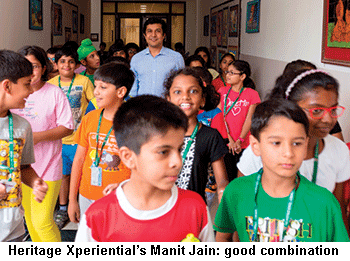 Manit Jain, a postgraduate of the renowned Harvard School of Education and promoter-director of the CBSE-affiliated Heritage Xperiential Learning School, Delhi (estb.2004), believes he has resolved this conundrum. “The mainstream education system is patently not working as evidenced by the rising unemployability of our university graduates. We have transformed into a country which casually awards paper degrees to youth with little attention to developing their real learning capabilities. In Heritage, our conscious attempt is to provide real, unforgettable learning by integrating experiential education through projects and activities into our teaching-learning processes, by eliminating subject boundaries. But we also believe that academic learning and rigour is important and it’s our responsibility to ensure that our children are admitted into best colleges and universities. Therefore in class IX and X, we prepare them intensively for board exams, which is not difficult given that they have a good foundation based on real learning of all subjects. Heritage is routinely ranked among the country’s Top 10 in terms of CBSE class X/XII board exam results,” says Jain.
Manit Jain, a postgraduate of the renowned Harvard School of Education and promoter-director of the CBSE-affiliated Heritage Xperiential Learning School, Delhi (estb.2004), believes he has resolved this conundrum. “The mainstream education system is patently not working as evidenced by the rising unemployability of our university graduates. We have transformed into a country which casually awards paper degrees to youth with little attention to developing their real learning capabilities. In Heritage, our conscious attempt is to provide real, unforgettable learning by integrating experiential education through projects and activities into our teaching-learning processes, by eliminating subject boundaries. But we also believe that academic learning and rigour is important and it’s our responsibility to ensure that our children are admitted into best colleges and universities. Therefore in class IX and X, we prepare them intensively for board exams, which is not difficult given that they have a good foundation based on real learning of all subjects. Heritage is routinely ranked among the country’s Top 10 in terms of CBSE class X/XII board exam results,” says Jain.
Although the rising popularity of alternative schooling is as yet an elite and upper class phenomenon, there’s no gainsaying that it’s overdue in an education system which imposes increasingly unbearable pressure on children to succeed in ill-conceived tests and examinations. As a consequence, there’s an emerging consensus within educators that the currently dominant memorising, cramming and sudden-death examination school education system which has substantially eliminated the pleasure of learning, needs urgent reform. Though some of the more extreme experiments in alternative schooling may fail — as did the Beacon Hill School promoted by the philosopher-mathematician and writer Bertrand Russell — India’s alternative schools have shown the way to go.
Indeed a combination of yoga, meditation and the Rishi Valley model of simple living, high thinking and ecology preservation schooling is an exportable model, certain to win global acceptance.
With Sruthy Susan Ullas (Bangalore)